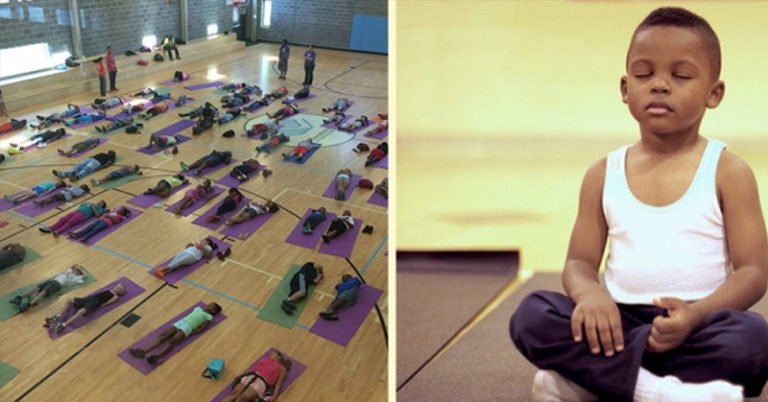While some of us were angels in the classroom during childhood, many of us likely got into trouble at least once or twice at school. Imagine, however, if teachers gave you meditation instead of detention for a misdemeanor. Do you think that would’ve made you behave better in the future?
One school in Baltimore is doing exactly that. Instead of sending their kids to detention when they misbehave, they have opted for a healthier approach to discipline. The results have been amazing.
Meditation Instead of Detention
In 2016, Robert W. Coleman Elementary School in Baltimore, Maryland, started a “Mindful Moment” program. When their students misbehave, the teachers don’t send them to detention. Instead, they send them to the “mindful moment” room- a well-lit space with floor pillows, yoga mats, and the scent of essential oils.
Here, the kids have an opportunity to stretch, do yoga, and practice deep breathing. The program teaches the children to wind down and reflect, and to breathe through tough situations.
The school is providing the program through a partnership with the non profit organization, The Holistic Life Foundation. There is a staff member from the foundation in the mindful moment room at all times, to help children work through their emotions.
When a student is disruptive in class, they are sent to the room, where the staff member encourages them to talk about what happened. They then go through some breathing exercises to help them calm down.
One young boy was sent to the meditation room after getting in a fight with another student.
“I did some deep breathing, had a little snack, and I got myself together,” he explained. “Then I apologized to my class.” [1]
Helping Struggling Kids
A majority of the students at Coleman Elementary come from troubling backgrounds. With almost 25 percent of Baltimore residents living below the poverty line, many of the kids don’t come from stable homes. In fact, eighty percent of the students qualify for free or reduced lunches.
The school’s principal, Carlillian Thompson, says that some of their students are homeless. Many of them don’t have food or even lights at home, and witness crime regularly. For this reason, the school is trying its best to create a safe space for the students wherein their needs are met.
“I’ve had a kid come in and look at me straight in the face with no emotions and say, ‘my grandfather got shot yesterday,” foundation co-founder Andres Gonzalez said. “So you can imagine what these kids have to face.” [1]
A Resounding Success
The school says that the program has done amazing things for its learning environment, and for student productivity. One student described how students who arrive in the meditation room are rowdy and goofing off. By the time they leave, however, they are calm, quiet, and ready to do their schoolwork.
Since the program began, Thompson says she barely ever sees students for disciplinary issues.
“It’s made a huge impact,” she says [1].
After the success of Coleman Elementary’s program, Patterson High School in East Baltimore has also started its own program. The school offers its own mindful moments room, where students can stretch, do yoga, or simply decompress at the end of the school day [1].
The Benefits of Mindfulness and Meditation for Children
Research has shown that practicing mindfulness and meditation can help ease psychological stress, anxiety, depression, and pain [2].
Much of this research, however, has focused on adults. Mindfulness, however, can be an incredibly useful exercise for children at every developmental stage. It can decrease their anxiety, help them deal with difficult situations, and promote happiness.
But what exactly does mindfulness mean? Put simply, it means paying attention to the present moment in an accepting, non-judgemental manner. Children can benefit from this practice in a unique way because they are so young.
Habits that children form during their early years will influence how they behave later in life. Childhood, then, is the perfect time to teach them habits that promote being calm, kind, and accepting. Annika Harris is an author who teaches mindfulness to children. She says that the practice can provide kids with relief from whatever difficulties they’re facing.
“It also gives them the beauty of being in the present moment.” [3]
There are many reasons why teaching mindfulness to children is so effective. One of these reasons has to do with the way our brains develop. During childhood, connections in our prefrontal cortex are formed at a faster rate than any other time in life. This area of the brain controls the skills that mindfulness promotes, like focus and cognitive control.
Because of this, teaching mindfulness to children can have a significant impact on the development of skills including self-regulation, judgment, and patience.
Other Schools Are Using Meditation Instead of Detention
Over the last four years, other schools have begun adopting similar approaches to discipline as Coleman Elementary. Horace Mann School in Beverly Hills, California, now offers sessions in mindfulness, self-awareness, and breathing instead of detention.
“We are trying to give a more positive feedback, instead of I’m going to yell at you because you’re in trouble and we want you to change your behavior; we are going to say let me give you some skills that you can use on your own, so that you can make your own choices and you can change your behavior,” explained special education teacher Joshua Reitzenstein [4].
The McKinney Disciplinary Alternative Education program in Texas has also begun a mindfulness and meditation program. Staff members at this school work with students who are trying to course-correct so they can return to their normal schools.
In the program, students sit on yoga mats, stretch, and meditate while music plays in the background. Meanwhile, school counselor Carrie Dewey quietly offers them instructions.
“It’s just a way of saying, ‘Bring all of your awareness to what you are doing right now,'” she said [5].
The program has been in operation for three years now, and now offers eight sessions per week. They are even using it during detention at the end of the school day, and Dewey says some students are now asking to go to detention even when they don’t have to.
Mindfulness and Meditation: Teaching Kids to be Adults
The staff members at each of these schools understand the importance of instilling good habits in children while they’re young. A significant motivator for the programs is to teach students healthy coping mechanisms that they can take with them as they become adults.
“You guys are growing into the people, the adults, you’re going to become,” Reitzenstein tells students at the end of a session. “And believe it or not, the choices you make now will impact and affect the way you get wired to be out in the world when you grow up.” [4]
There may be a lack of scientific data to demonstrate the benefits of mindfulness and meditation in children, but the anecdotal evidence seems promising. Plus, what child wouldn’t prefer meditation instead of detention? Mindfulness practice teaches kids how to deal with life’s stressors. The hope is that these skills will follow them into adulthood.
Keep Reading: F*ck That: The Hilarious Guided Meditation For Realists That Actually Works
Sources
- ‘Instead of detention, these students get meditation’ CNN Deborah Bloom. Published November 8, 2016.
- ‘Meditation Programs for Psychological Stress and Well-being’ JAMA Network Madhav Goyal, MD, Sonal Singh, MD, Erica M. S. Sibinga, MD. Published March 2014.
- ‘Mindfulness for Children‘ New York Times David Gelles
- ‘Ditching Detention for Yoga: Schools Embrace Mindfulness to Curb Discipline Problems’ Ed Week Sasha Jones. Published May 23, 2019
- ‘This McKinney school swaps detention for mindfulness and meditation’ WFAA Jobin Panicker. Published February 12, 2020

